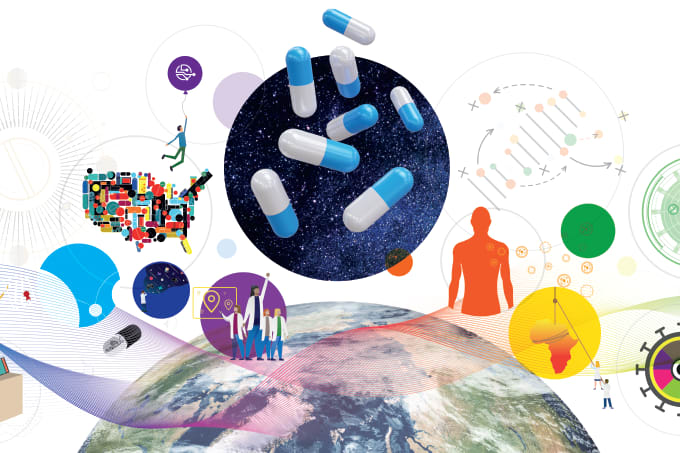
Cell and gene therapy is at a fascinating inflection point. After proving itself in blood cancers, the field is now pushing into the far more complex territory of solid tumors. We’re beginning to see encouraging data from CAR T-cell programs in indications such as melanoma and non-small cell lung cancer, alongside tumor-infiltrating lymphocyte (TIL) therapy, which has achieved FDA approval in metastatic melanoma. CAR-NK cells are also moving through the clinic, with early-phase studies testing targets such as B-cell maturation antigen and prostrate-specific membrane antigen. The motivation here is clear, to broaden patient reach. But the obstacles are equally clear, an immunosuppressive tumor microenvironment (TME), antigen heterogeneity, and the persistent challenge of trafficking engineered cells into solid tumor sites.
At the same time, the therapeutic toolbox is rapidly diversifying. CAR T-cells are evolving into "armored" variants, equipped to secrete cytokines or express additional receptors that help them withstand suppression, while multi-specific CAR designs are being developed to reduce the risk of antigen escape. TIL therapy, validated in melanoma, is now being studied in other solid tumor contexts. CAR-NK approaches offer the promise of an off-the-shelf product with potentially lower toxicity risks, while entirely new platforms, including macrophage-based and γδ T-cell therapies, are entering early clinical exploration. Each of these modalities reflects a broader ambition: to refine safety, scalability, and efficacy across a wider range of diseases.
Further along the innovation curve is the idea of in vivo CAR-T. Rather than removing and engineering cells outside the body, this approach delivers CAR-encoding genetic material directly into a patient’s T cells, typically using viral vectors or nanoparticle-based carriers. This avoids the lengthy ex vivo process and opens the door to faster, more cost-effective, and potentially safer therapies. Phase I studies have recently begun, and major pharmaceutical investment in this space suggests a strong belief in its transformative potential.
In parallel, we’re seeing an increasing emphasis on combination strategies. Whether pairing cell therapies with checkpoint inhibitors, targeted small molecules, oncolytic viruses, or novel conditioning regimens, the goal is to remodel the TME and improve both depth and durability of response.
What makes this moment inspiring is not just the technical innovation but the creativity driving it. Researchers are moving past the “one-size-fits-all” model and inventing entirely new ways to harness the immune system. We are collectively writing the next chapter of cancer treatment, where therapies are not only more powerful, but also more versatile and more accessible to the patients who need them.
Preclinical challenges and tips for success
In preclinical development, the biggest challenges stem from translating promising lab results into clinically relevant, safe, and manufacturable products. One common mistake is over-interpreting small-scale efficacy data without adequate replication or controls. In cell and gene therapy research, tumor shrinkage in animal models is also often treated as the primary proof of efficacy. However, this can be misleading because tumor regression alone does not capture critical factors that drive clinical success, such as cell persistence, trafficking to disease sites, immune memory, and the ability to overcome an immunosuppressive TME. A more predictive approach combines tumor volume measurements with mechanistic and functional endpoints to better anticipate human outcomes.
Key challenges include:
Predictive modelling. No single animal model or in vitro platform fully recapitulates human immune responses, making translation uncertain. That’s why integration is so important, using combinations such as in vitro co-culture systems (for instance, organoids with CAR-T cells) alongside in vivo models, whether subcutaneous, disseminated, or orthotopic, to build a more holistic picture.
Antigen selection and specificity. A recurring concern is on-target/off-tumor toxicity, where a carefully chosen antigen still turns out to be expressed in healthy tissues. One solution is thorough expression profiling, drawing on large biobanks of normal and tumor tissues, and where possible, functional testing in matched organoid pairs derived from the same patient (normal vs tumor).
Persistence and exhaustion. Predicting long-term CAR-T cell persistence, or conversely, early exhaustion, from short-term preclinical assays remains a blind spot. We’ve learned to lean on pharmacokinetic-pharmacodynamic studies in combination with qPCR versus ddPCR to track transgene persistence as a way of bridging this gap and addressing the question.
Safety assessment. Serious clinical toxicities, such as cytokine release syndrome, neurotoxicity, and unexpected off-target effects, are extremely difficult to predict preclinically. Developers need to rely on biodistribution studies, cytokine profiling, and immune activation assays.
Successful programs integrate translationally relevant models, robust safety testing, and scalable manufacturing considerations from the outset. It’s important to start with a translationally relevant model strategy. No single system is sufficient, so multiple complementary models should be combined. In vitro tools such as organoids and co-culture assays can help dissect mechanisms, ex vivo patient-derived samples provide closer-to-human biology, and in vivo models remain essential for understanding efficacy in a whole-system context. For persistence and safety, moving beyond immunodeficient mice to humanized systems (for example, HSC-humanized models) can offer a clearer view of long-term potential. In solid tumors, incorporating orthotopic or metastatic models rather than relying only on subcutaneous systems adds translational value.
Safety and the need for improved testing
Safety should be prioritized early. It’s tempting to focus exclusively on efficacy, but early safety signals can make or break a program. Incorporating off-target, dose-ranging, and biodistribution studies from the outset provides a foundation for trial design. Likewise, leveraging human-relevant assays, such as cytokine release profiling from peripheral blood mononuclear cell co-cultures, can reveal risks that might not be visible in animal models.
In fact, one of the biggest gaps right now in the preclinical space is prediction. Animal models have been invaluable, but they still fall short when it comes to anticipating how a cell or gene therapy will behave in humans. Efficacy, persistence, and toxicity are particularly hard to model. For example, cytokine release syndrome, neurotoxicity, or subtle off-target immune effects often don’t show up until human trials – because most animal systems simply don’t replicate those pathways well enough. We need models that better reflect human immune responses, tissue complexity, and the heterogeneity we see across patients.
Looking ahead, there are several tools and technologies I’d love to see pushed forward:
Advanced humanized mouse models. The ideal system would have a fully functional human immune system, stable engraftment of human tissues, and the durability to allow long-term studies. That would give us a much clearer window into persistence, trafficking, and immune-mediated toxicities.
High-throughput ex vivo human immune assays. Testing therapies against panels of peripheral blood mononuclear cells, tumor slices, or patient-derived organoids in parallel. That kind of throughput screens for both efficacy and safety, while also flagging which patient subgroups might benefit most.
AI-driven in silico predictive platforms. Integrating omics, structural biology, and preclinical datasets could help us forecast off-target effects, predict immunogenicity, and even optimize dosing before moving into animal or human studies.
The future of personalized medicine
The future lies in moving toward systems that are more human-centric and predictive, such as greater use of organoids, organ-on-a-chip platforms, and advanced humanized mouse models that better reflect human immune biology and tissue complexity. Standardized, validated assays for immune-mediated toxicities, insertional mutagenesis, and long-term genomic stability will also be critical, giving regulators and developers a more consistent baseline for safety.
Yet these are not the only exciting technologies making waves in drug development. For example – digital twins. These computer models simulate a patient’s biology, so you can essentially create a virtual copy of someone and test therapies in silico before moving into the lab. What makes this so powerful is the ability to run hundreds of "what if" scenarios in minutes, predicting, for example, how an individual’s immune system might respond to a new CAR-T therapy, without any risk to a real patient. If realized, this could make preclinical research not just a safety net, but a driver of personalized medicine.
AI-designed gene editors are also exciting. CRISPR has revolutionized genetic engineering (see sidebar), but what’s happening now is the use of artificial intelligence to design entirely new gene-editing enzymes that don’t exist in nature. These AI-guided editors can be made more precise, less immunogenic, and better suited to reach hard-to-edit cell types. It’s an area where computation and biology are colliding in a powerful way.
There are also advances being made in real-time tracking of therapies inside the body. New imaging technologies are giving us the equivalent of a GPS tracker for cell and gene therapies. With tools like Positron Emission Tomography imaging, we can follow engineered immune cells as they move through the body, watch how long they persist, and even see them interacting with tumors in real time. It’s not just visually striking, it gives us critical data on trafficking, persistence, and therapeutic mechanism.
Such advances demonstrate why preclinical research is more than just a stepping-stone to clinical trials. It’s a space where innovation happens; where you see the convergence of digital tools, live imaging, and molecular engineering, all working together to push the boundaries of what’s possible in precision medicine.
What About Developments in CRISPR/Cas9?
The hype is starting to give way to early clinical reality. We’ve moved past the point where CRISPR was just a laboratory tool and we're now seeing genuine early clinical successes. For example, CRISPR editing is being used to knock out endogenous T-cell receptors, PD-1, or human leukocyte antigen molecules to create allogeneic CAR-T therapies. There’s also exciting progress in NK cell engineering, where editing can enhance persistence, cytotoxicity, and resistance to suppression in the TME, capabilities that are critical for making cell therapies more durable.
The first in vivo CRISPR therapy, NTLA-2001, showed durable protein knockdown in humans after just a single infusion, proving that in-body editing can work. Multiplex editing, where several genes are targeted simultaneously, is also edging closer to commercial viability in allogeneic CAR-T programs, which was unthinkable just a few years ago.
But significant challenges remain. Delivery is still the single biggest bottleneck, particularly outside the liver. Off-target effects and large genomic rearrangements are still concerns, and the more edits you introduce, the more complex the manufacturing process becomes.




